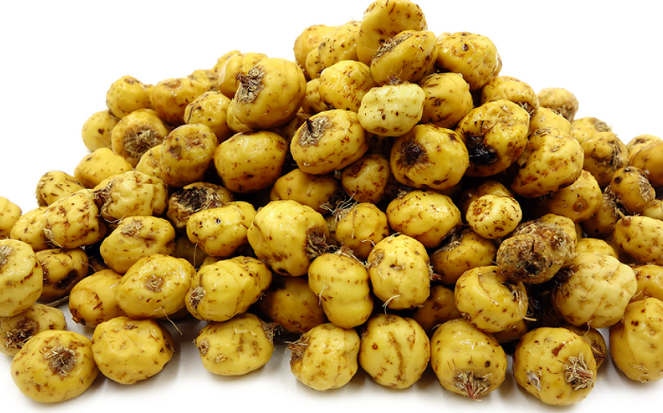The sweet nutty flavor of the Tiger nut is one of the reasons why it is loved by many people, however, crunching on the wrinkly tiger nut will give you more than a sweet delicious flavor.
There are many benefits you can get from eating tiger nut and drinking tiger nut milk. These benefits are due to the numerous nutrients in the tiger nut that have been linked to several health benefits.

What is Tiger Nut?
The words, tiger nut, might sound foreign to you, but it is one of the most popular edibles that you probably have taken more than once.
Tiger nut is commonly known as “Hausa groundnut” in Nigeria. Despite its name, Tiger nuts have nothing to do with Tigers or nuts. They are actually edible tubers and one of the worst weeds in the world.
While most weeds are meant to be discarded, the tiger nut offers some goodness that has made it one of the top edibles in the markets all over the world.
They were one of the first plants cultivated in Egypt for use as food and medicine. Over the years, its popularity has grown and it is taken by many people as a snack.
Health Benefits of Tiger Nut
Improves Digestion
Tiger nut could improve digestion in several ways. The insoluble fiber in tiger nuts adds to the bulk of your stools and promotes the movement of food through your gut with ease. This reduces the likelihood of constipation as the fiber passes through the gut without being digested.
Tiger nuts also contain resistant starch that can feed the friendly bacteria in the gut and promote healthy digestion. Additionally, several enzymes found in tiger nuts break down foods in the gut and relieve indigestion and diarrhea.
Promotes the Proper Functioning of the Body
Tiger nut can help in improving the proper functioning of the body through the supply of potassium. Potassium is one of the minerals that aid in the proper function of the body organs such as the heart.
Potassium is responsible for other functions in the body such as regulating fluid balance, nerve signals, and muscle contractions. It is also responsible for reducing blood pressure and water retention.
Low levels of potassium in the body can lead to heart problems and weak muscles. Taking tiger nut which is a rich source of potassium is a great way to ensure that you are making up for any potassium deficits in your diet.
Rich Source of Nutrients
Tiger nuts are rich in a variety of nutrients which have been linked to several health benefits. The nutrients and beneficial plant compounds that can be gotten from Tiger nut will depend on the type. There are three main types of tiger nuts; brown, black, and yellow.
Some of the nutrients found in Tiger nuts include
- Carbohydrate
- Calcium
- Proteins
- Iron
- Fat
- Vitamin E
- Fibre
- Phosphorus
- Magnesium
- Potassium
- Zinc
Tiger nut also contains antioxidants which help protect the body against diseases and aging. However, they are also a source of antinutrients, such as oxalates, tannins, and saponins which can reduce nutrient absorption in the body.
It is best to roast the tiger nuts before eating to increase their antioxidant content and reduce their antinutrient levels.
Promotes Heart Health
Taking tiger nuts will go a long way in improving the health of your heart. They contain a high amount of monounsaturated fats which have a fat profile consistent with that of heart-healthy olive oil.
Monounsaturated fats have been linked to higher levels of “good” HDL cholesterol and lower levels of bad “LDL cholesterol. They also reduce the risk of heart attack, stroke, and heart diseases.
Another nutrient in tiger nut that promotes heart health is the amino acid arginine. The body makes use of arginine to make nitric oxide, a compound that lowers blood pressure by helping the arteries and veins dilate.
Reduces Blood Sugar Levels
Several studies have proven that eating tiger nut regularly can help to keep your blood sugar level in check. This effect is believed to be due to the high fiber content of the nut which slows down the absorption of sugar in the gut.
Another way tiger nuts lower the blood sugar level is through an amino acid arginine. Arginine increases insulin production and sensitivity, both of which are necessary for blood sugar control.
Tiger Nut Milk
Tiger nut milk can be extracted from tiger nuts. It can serve as a substitute for animal milk as it is a rich source of calcium and vitamins. Also, it does not contain lactose making it one of the healthiest milk choices that you can make in your kitchen.
How to Make Tiger Nut Milk
Ingredients
- A bowl of raw tiger nuts
- A glass of water
- Coconut, sugar, and ginger (these are optional ingredients that boost the flavor of the milk. You can go without them if you prefer the natural taste of the Tiger Nut milk.
Instructions
- Soak the raw tiger nuts in cold water for 48 hours (2 days). The nuts should be kept in the fridge during soaking. If you buy the nuts from sellers, you may only need to soak it overnight.
- After soaking, wash the nuts with cool water and then pick out the bad nuts.
- Place the nuts in the blender. It is best for you to use a powerful blender that can puree the nuts. Add a little bit of water to ensure that the blades move easily. You want to end up with concentrated and tasty milk, so avoid pouring a lot of water into the blender.
- Before you start blending, add any ingredient you think will improve the taste of the milk (you can go with sugar and coconut). When done, blend together till it turns into a mixture.
- After blending, use cheesecloth to separate the chaff from the milk. You can put the chaff back into the blender, add more water and blend to extract more milk. When done, you can separate the chaff from the milk with the cheesecloth (You should repeat this process twice to get more milk).
- Once all the milk has been extracted, pour it into bottles and store in the fridge. You shouldn’t allow it to stay for more than 2 days in the fridge.
You can serve your Tiger Nuts milk with a snack or drink it alone.


